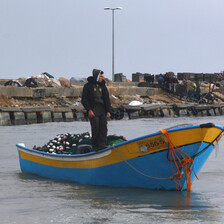The Electronic Intifada 30 September 2010
GAZA CITY, occupied Gaza Strip (IPS) - “Sometimes, for a day or two we don’t even have bread, nor flour to make bread. There’s a store nearby that, when we are truly desperate, lets us take a bag of bread or something simple, on credit. I owe them a lot of money for the food I’ve brought from them, but I still can’t pay them.”
Umm Khamis Khattab, 52, lives in a single, bare-bones room in central Gaza’s Bureij refugee camp. Khamis, her disabled son, 30, is married but has no source of income.
“Our situation is very bad. We used to receive financial support because my son is disabled. Now, we get nothing. After my husband died five years ago, his family tried to help us, for a short while. But they can’t take care of themselves, let alone us,” says the widow. “So we get by on hand-outs from neighbors now and then.”
Umm Khamis tries to generate an income selling eggs from the handful of chickens she tends. “We are three people living off 20 shekels (roughly $5) per week from the eggs.”
The World Food Programme (WFP) and Food and Agriculture Organization (FAO) define food insecurity as people not having “adequate physical, social or economic access to sufficient, safe and nutritious food which meets their dietary needs.”
Palestinians vulnerable to food insecurity are further defined as “households with both income and consumption below 5.6 dollars per adult equivalent per day.” Actual food insecure households are defined as having “an income and consumption below 4.7 dollars per adult equivalent per day.”
In the Gaza Strip, where unemployment levels soar up to 65 percent, and more than 80 percent people are food aid dependent, the average income per day per person is just two dollars. According to the WFP and FAO, the food insecure in Gaza are an alarming 61 percent, with another 16 percent vulnerable to food insecurity.
“I’d be happy just selling things on the street if it brought five shekels per day,” says Abu Suleiman, 51, father of four. He, his wife and their young children live in Sheik Radwan, north of Gaza City, in a windowless, concrete block room, the kind that is ordinarily used as a space for small shops.
“We all sleep together in this room, which is our kitchen and bathroom as well,” he says.
The building owner uses the room next door for his sheep and chickens. “The stench is incredible, we can’t escape it. And I worry about my children’s health, but there’s nowhere better we can go.”
Abu Suleiman works making tea and coffee and cleaning the office of a media group in Gaza. “I work from 7am to 4:30pm and earn just 350 shekels per month,” he says. “The rent for our room is 150 shekels per month, so that leaves just 200 shekels to get by on.” He says he walks the hour both ways to work in order to avoid taxi fares.
“But 200 shekels isn’t enough for five people and a baby. If I even thought about buying meat, the money would be gone quickly. So we buy cheaper food: rice, lentils, pasta. Never meat.”
With food prices highly inflated under the siege Israel has imposed on Gaza since shortly after Hamas’s election in 2006, few families can afford meats, fish, or fresh produce. The 2008-2009 Israeli assault on Gaza further destroyed meat and poultry production besides devastating the agricultural sector.
Ten percent of poultry and 17 percent of cattle and ruminants were killed. Eighteen percent of Gaza’s productive agricultural lands were destroyed, along with another 17 percent of greenhouse-grown vegetables, says the UN.
The combination of this agricultural destruction and the mortal Israeli imposition of a no-go zone on Gaza’s border lands, encompassing roughly one-third of Gaza’s arable land means that as of June 2009, 46 percent of agricultural land in Gaza was either inaccessible or out of production, impacting on the availability of fresh and nutritious produce in the Strip and affecting over 60,000 people earning a living from agriculture alone.
At the same time, fishers are no longer able to breach more than miles, most usually staying within less than a mile of Gaza’s shores. While the Oslo accords granted Gazan fishermen the right to fish twenty nautical miles off Gaza ‘s coast, Israel has incrementally and violently reduced the fishing limits.
The FAO reports a decline in total fishing catch by 47 percent between 2008 and 2009, with fishers subject to daily shooting from Israeli gunboats in Gazan water.
“Every day in Gaza, more and more people become hungry, more new people come for help,” says Dr. al-Wahaidi, Director of Health for Ard al-Insan, Gaza’s prime center for the hungry and malnourished. “And there’s no difference between city dwellers and camp residents, except that maybe camp families have more of a social network to rely on, and country residents have more possibilities for growing produce for themselves.”
According to Amani Jouda, Nutrition Officer for the World Health Organization (WHO) in Gaza, 74 percent of children aged 9-12 months are anemic, up from 65 percent in 2009, as are another 32 percent of children aged 7-15 years, and 45 percent of pregnant women in their first months of pregnancy.
The UN Millennium Project Hunger Task Force cites the importance of local agriculture and livestock in reducing hunger.
Ard al-Insan’s Dr. al-Wahaidi sees it clearly. “The main reason for hunger in Gaza is Israeli politics on the people Gaza. Gaza is different than other places. When we have a disaster, we cannot leave our small piece of land to find work or safety elsewhere. We are trapped inside.”
All rights reserved, IPS — Inter Press Service (2010). Total or partial publication, retransmission or sale forbidden.




